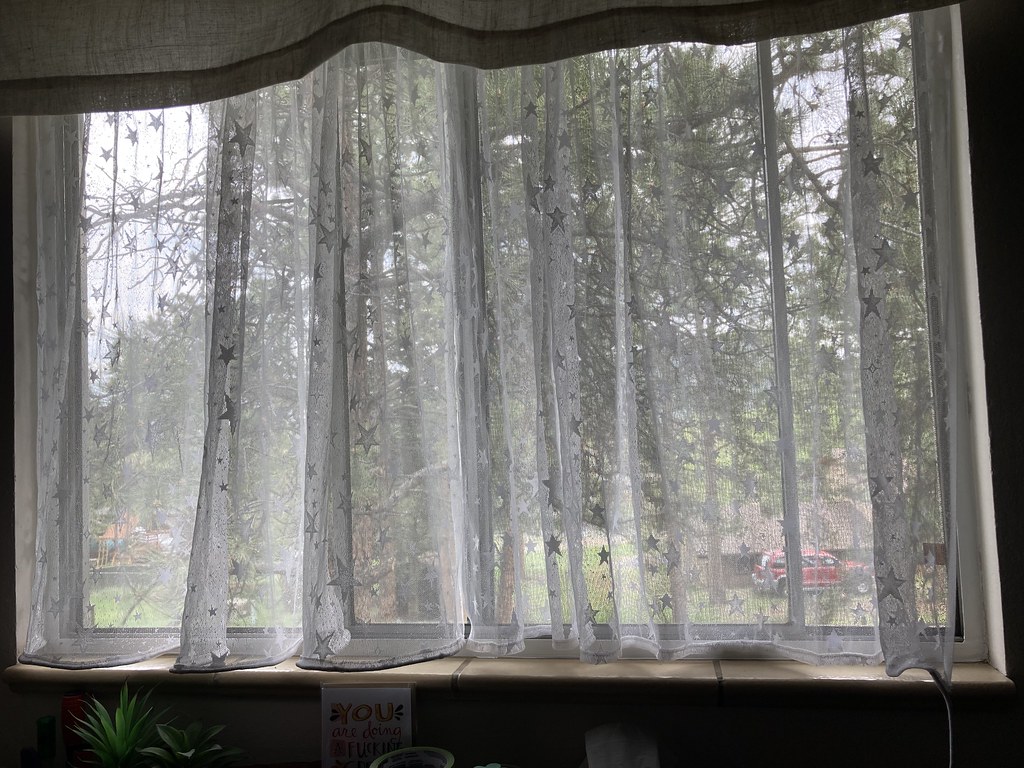The Magic of Vertical Stripes
Vertical stripes on curtains work like magic for making your ceiling appear higher than it actually is. Interior designers have been using this trick for decades because our eyes naturally follow the lines upward, creating an optical illusion that stretches the room. Studies show that vertical patterns can make a room appear up to 20% taller than it really is. You don’t need bold, contrasting stripes either – subtle tonal variations work just as well. Think of it like wearing vertical stripes on your body – they make you look taller and slimmer.
Hanging Curtains Close to the Ceiling
The single biggest mistake people make is hanging their curtains too low, right above the window frame. Professional interior designers recommend mounting curtain rods as close to the ceiling as possible, ideally 4-6 inches from the ceiling line. This simple change can instantly add visual height to any room, regardless of your actual ceiling height. The space between your curtain rod and ceiling should be minimal – think of it as creating one continuous vertical line from floor to ceiling. Even in rooms with 8-foot ceilings, this technique can make the space feel like it has 9 or 10-foot ceilings.
Floor-to-Ceiling Length Creates Drama
Curtains that puddle slightly on the floor or just graze it create an unbroken vertical line that draws the eye upward. The key is ensuring your curtains are long enough – they should never hover awkwardly above the floor. Interior design research from 2024 shows that curtains hanging 1-2 inches above the floor actually make rooms look shorter, not taller. Professional decorators often order curtains that are 2-4 inches longer than the floor-to-ceiling measurement to achieve that perfect drape. This creates what designers call “visual weight” at the bottom, which anchors the eye and makes the ceiling appear higher by comparison.
Light Colors Reflect and Expand
Light-colored curtains reflect natural light around the room, creating an airy feeling that makes spaces appear larger and taller. White, cream, pale gray, and soft pastels work exceptionally well for this purpose. According to lighting studies conducted in 2023, rooms with light-colored window treatments reflect up to 80% more light than those with dark curtains. This reflected light bounces off the ceiling, making it appear higher and more spacious. Dark curtains absorb light and can make even tall rooms feel cramped and cave-like.
The Power of Monochromatic Color Schemes
Choosing curtains that match or closely complement your wall color creates a seamless look that eliminates visual breaks in the room. This technique, called “color drenching,” has become increasingly popular among interior designers in 2024 and 2025. When curtains blend with the walls, your eye doesn’t stop at the window treatment – instead, it continues upward to the ceiling. The lack of contrast creates an uninterrupted vertical flow that makes rooms appear significantly taller. Think of it like wearing a monochromatic outfit – everything flows together to create one long, elegant line.
Sheer Fabrics Let Light Flow Freely

Sheer or semi-sheer curtains allow maximum light penetration while still providing privacy and style. Light is crucial for creating the illusion of height – dark, heavy fabrics can make even tall rooms feel low and oppressive. Linen, cotton voile, and silk organza are excellent choices that filter light beautifully while maintaining an airy feel. Recent home design trends from 2025 show that layering sheer curtains behind heavier panels gives you flexibility while maintaining that light, height-enhancing quality. The translucent quality of sheer fabrics creates depth and dimension that adds to the room’s vertical appeal.
Narrow Panels Create Vertical Lines
Using multiple narrow curtain panels instead of one wide panel creates more vertical lines in your space. Each panel edge forms a vertical line that draws the eye upward, multiplying the height-enhancing effect. Interior designers recommend panels that are 1.5 to 2 times the width of your window for proper fullness without being overwhelming. This approach works particularly well on wide windows where one large panel might look heavy and drag the eye downward. Think of narrow panels as creating a series of elegant columns that frame your window beautifully.
High-Contrast Trim and Borders
Adding vertical trim or borders to plain curtains creates strong vertical lines that emphasize height. This technique works especially well with solid-colored curtains where you can add ribbon, braid, or contrasting fabric strips along the leading edges. The contrast creates definition and draws attention to the vertical lines of your window treatment. Professional interior designers often use this technique in rooms with moderate ceiling heights to create dramatic impact. However, make sure any horizontal elements like tiebacks or borders are minimal to avoid breaking up those important vertical lines.
The Width Factor
Wider curtains that extend well beyond your window frame create the illusion of larger windows and, consequently, taller rooms. Design experts recommend extending curtain rods 6-12 inches beyond each side of the window frame when space allows. This technique makes your windows appear larger and more proportional to the room, which enhances the overall sense of height. The extra width also allows more light to enter when curtains are open, contributing to that bright, airy feeling that makes ceilings seem higher. Just imagine how a narrow window treatment would make even a tall room feel cramped and vertical space wasted.
Modern Minimalist Hardware
Sleek, minimal curtain rods and hardware keep attention focused on the vertical lines of your curtains rather than decorative elements. Chunky, ornate hardware can overwhelm a room and create visual clutter that detracts from height. Contemporary design trends for 2025 favor thin metal rods, simple brackets, and clean lines that virtually disappear into the room’s architecture. The goal is to create an uninterrupted flow from floor to ceiling without distracting elements. Think of your hardware as the supporting actor – it should enhance the performance without stealing the show.

Kelly Westler is a celebrated designer and author specializing in bold, eclectic interiors. Her book The Art of Spaces showcases her signature mix of colors, textures, and vintage influences, inspiring homeowners to embrace fearless design.
